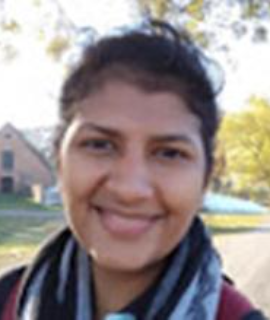Title : Layer growth dynamics in compound nanowires studied by in-situ microscopy
Abstract:
Nanowires are often grown by the vapor-liquid-solid (VLS) mechanism whereby the reactants supplied in the vapor phase dissolves in the liquid metal, supersaturates and eventually precipitates layer-by-layer as a solid nanowire. This liquid alloy is referred to in the nanowire community as a ‘catalyst’ though the exact role of this liquid alloy is still controversial. The exact dynamics of the nanowire is also still unclear. In-situ transmission electron microscope (TEM) during growth of nanowires inside a TEM provides directly interpretable results. Here we discuss compound nanowire growth mechanism studied by in an environmental TEM, using GaAs as a representative example. Au nanoparticles are used to seed the growth.
While the nanowires were growing at different conditions, we measured the particle composition using energy dispersive X-ray spectroscopy.1 There is significant amount of Ga alloyed into the Au seed particle, but there is hardly any As in the catalyst1, in agreement with theoretical predictions. This asymmetry in the catalyst composition to the two different components – As and Ga – effects the layer growth dynamics. Growth dynamics in nanowires have two important parts – the nucleation of each layer at the catalyst-nanowire interface followed by lateral growth of the nucleus to a full bilayer. Unlike assumed by most theoretical models of nanowires, and unlike observed in growth of elemental nanowires, the layer completion is not instantaneous.2 We observe that the Ga flow directly controls the nucleation of each new layer, without a direct effect on the layer completion process. Arsenic on the other hand limits the completion of each nucleated layer. Thus, owing to the difference in solubility of Ga and As in the catalyst it is possible to controlling nucleation and layer growth using precursor flow independently.2
An alternate mechanism, where the catalyst used for promoting axial growth of nanowires is a solid, is called the vapor–solid–solid (VSS) mechanism. VSS offers certain advantages compared to the common VLS route, however, it is much lesser understood than the VLS route. The in-situ TEM investigation of VSS growth of compound nanowires has been recently reported.3. The layer growth kinetics and dynamics at the wire–catalyst interface are investigated for liquid and solid catalysts under similar growth conditions. The temperature and thermal history of the system are manipulated to control the catalyst phase. The VSS growth rate is comparable or slightly slower than the VLS growth rate. The incubation time for the VSS growth is not necessarily very different from the VLS counterpart. Layer completion time is found to be very similar for VLS and VSS under comparable growth conditions, indicating that the diffusion of reactants through the solid catalyst particle during VSS growth is not the growth rate limiting step. During VLS growth each new layer started only after the completion of the previous layer, while occasions with multilayer growth is observed during VSS.
Audience take-away:
- Strategy to measure composition of nanomaterials at elevated will be explained.
- A direct comparison of nanowire growth dynamics when two different phases of catalyst (i.e. solid and liquid) are investigated.
- Though nanowires are promising for future technological applications, a deep understanding of the growth process is still lacking. In-situ TEM can provide valuable insights to understand nanowire growth, in turn enabling intentional engineering of nanowire properties.


